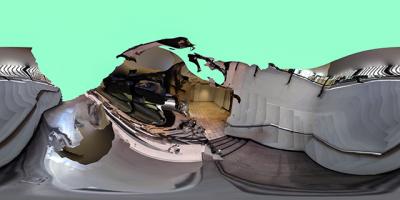Fresh Faces at Ille Arts

Like a breath of fresh air, 11 young artists ranging in age from 18 to 29 have taken over Ille Arts, bringing about a kind of spring renewal in Amagansett.
Young artists have been attracted to the East End for decades and come and go as opportunities and housing flow and ebb. This group was brought together by Sara De Luca, the gallery director, and her assistant Brianna Ashe, an artist who has work in the show. They wanted to honor a new generation while not strictly adhering to geographic limitations.
In addition to Ms. Ashe, the exhibitors are Amanda Brown, Glorimar Garcia, Evan Halter, Claire Hentschker, Adam Jonah, Burleigh Morton, Kevin Pomerleau, Sara Salaway, Morgana Tetherow Keller, and Ella Wearing. Ms. Ashe, Ms. Salaway, Ms. Keller, Mr. Pomerleau, Mr. Morton, Ms. Wearing, and Ms. Brown, who is Ms. De Luca’s daughter, have East End ties; the others come from UpIsland, Brooklyn, and as far away as Massachusetts.
With loose geometric shapes that can seem jewel-like or representational, Ms. Ashe’s work is marked by text and word play with tart irony. In a drawing titled “Journey to the High Point and Clap,” the words “Half Sour” hang in a purple cloud over boxes that look like an urban landscape viewed from a drone. Is it the air quality or a mood that she is describing? “I have personal standards,” she says in black lettering on a purple-striped background in “Will Tell You Twice.” In a free-floating installation of small mounted objects, “Little House on Lincoln,” she collects figures, tickets, plastic teeth, toy cars, a Scrabble tile, birthday candles, and more, evoking a family history culled from a junk drawer.
Mr. Morton also evokes the past, with platinum palladium photographic prints in frames he makes himself. This older process, most popular in the 19th century, makes contemporary landscapes feel historical. It brings out a moodiness that the artist may or not be feeling, but at the very least an ironic distance from modern life.
Adopting the techniques of 19th-century American trompe l’oeil still life, Mr. Halter’s paintings of flowered fabrics draped over frames and other objects still manage to push the limits of flatness and two-dimensionality, while creating an illusion of its opposite.
Ms. Brown does something similar in her otherwise abstract paintings. In an untitled work resembling a series of patterned lines with no references to naturalism, she coaxes the eye to find the relationship to an object, in this case a block of wood. It’s a delightful surprise, and it makes her other, more specific paintings — “Sun on a Building” and “Lake” — seem that they are more than what they appear to be.
Also confronting the notion of illusionism in painting is Ms. Wearing, whose triptych “Plot I, Plot II, Plot III” lines up squares to look like the cubes we all doodled as children. Her objects look more like glass vessels with solid-colored bottoms. Her more representational constructions build on the overlapping of squares and rectangles, in complicated configurations.
Ms. Keller works with shapes and lines, but her dense compositions look like building and room layouts all tumbled together. She introduces needlework as well, with stitched segments that look machine-made and others that appear more hand-stitched and homespun.
Mr. Pomerleau depicts curtains and fabric on rods and clotheslines that veer off on the diagonal and help advance the underlying theme of illusionism and geometry.
These artists seem to work the best together, thematically and visually, but each of the others still has something in common with at least one other.
Ms. Salaway’s “Salt and Silver, 1-6” uses the old photographic techniques, like Mr. Morton, but the hints of subject matter and her salt-and-silver prints on long strips of crumpled and torn paper look much different. Ms. Garcia’s “What If There Are People You Can Never Untie Yourself From?” is a pair of shadowboxes that hold playing card-size images embellished with stitching and thread. Ms. Hentschker’s photos are abstracted 360-degree views of what look like damaged interiors.
Standing almost completely apart from the rest of the show is Adam Jonah’s “United Imagination” project, a series of photographs with ink drawings on them, mounted under a covering that can be further drawn upon. He encourages viewers to add their own images, which can be erased at the end of the day for new encounters. When one of these is purchased, another one is donated to a school, a hospital, a library, or similar organizations.
The exhibition is on view through Monday.
